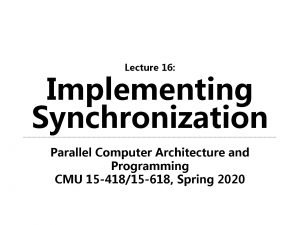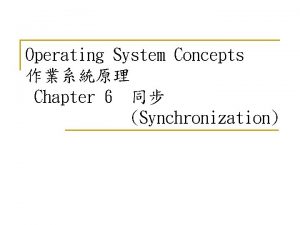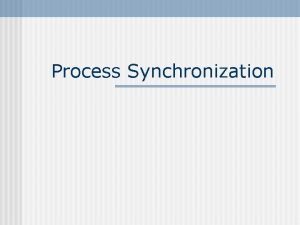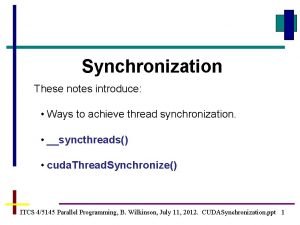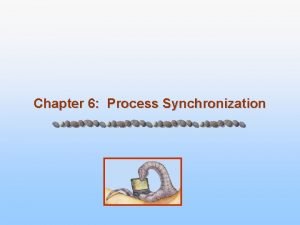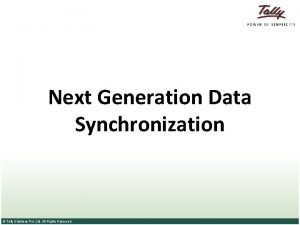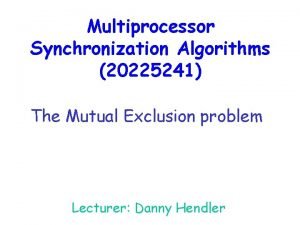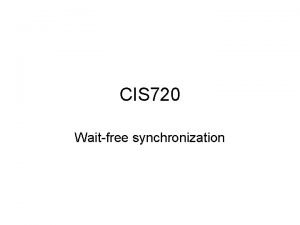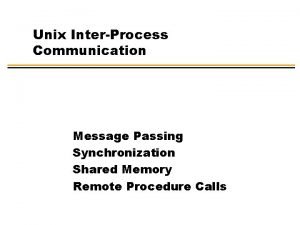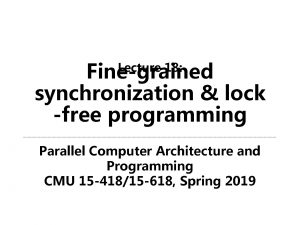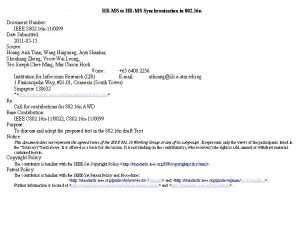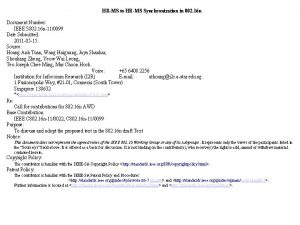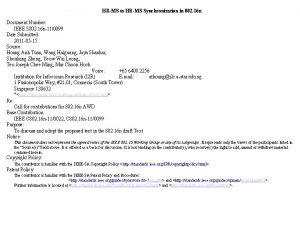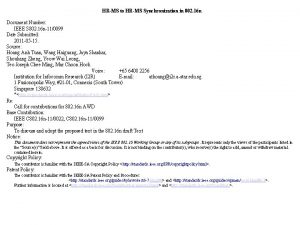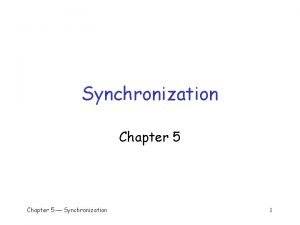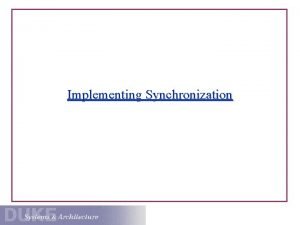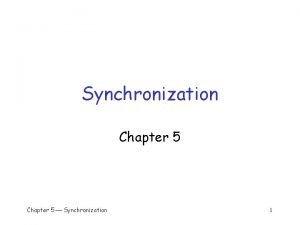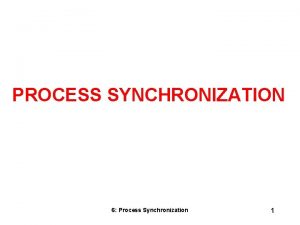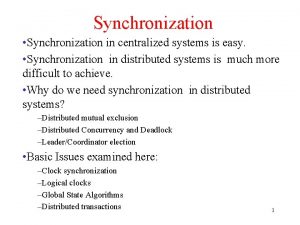HRMS to HRMS Synchronization in 802 16 n












- Slides: 12

HR-MS to HR-MS Synchronization in 802. 16 n Document Number: IEEE C 802. 16 n-11/0022 r 2 Date Submitted: 2011 -03 -14. Source: Hoang Anh Tuan, Wang Haiguang, Jaya Shankar, Shoukang Zheng, Yeow Wai Leong, Teo Joseph Chee Ming, Mar Choon Hock Voice: +65 6408 2256 Institute for Infocomm Research (I 2 R) E-mail: athoang@i 2 r. a-star. edu. sg 1 Fusionopolis Way, #21 -01, Connexis (South Tower) Singapore 138632 Re: Call for contributions for 802. 16 n AWD Base Contribution: IEEE C 802. 16 n-10/0022 Purpose: To discuss and adopt the proposed text in the 802. 16 n draft Text Notice: This document does not represent the agreed views of the IEEE 802. 16 Working Group or any of its subgroups. It represents only the views of the participants listed in the “Source(s)” field above. It is offered as a basis for discussion. It is not binding on the contributor(s), who reserve(s) the right to add, amend or withdraw material contained herein. Copyright Policy: The contributor is familiar with the IEEE-SA Copyright Policy <http: //standards. ieee. org/IPR/copyrightpolicy. html>. Patent Policy: The contributor is familiar with the IEEE-SA Patent Policy and Procedures: <http: //standards. ieee. org/guides/bylaws/sect 6 -7. html#6> and <http: //standards. ieee. org/guides/opman/sect 6. html#6. 3>. Further information is located at <http: //standards. ieee. org/board/pat-material. html> and <http: //standards. ieee. org/board/pat >.

Introduction • 802. 16 n SRD mandates HR-MS direct communications (DCm) and HR-MS forwarding to network (FTN) • To enable DCm/FTN, HR-MSs must achieve frame-level synchronization and OFDMA-symbol-level synchronization so that: • resources can be scheduled/allocated • interference can be controlled • transmissions can be reliably received

Use Case 1: Both HR-MSs under Coverage of HR-BS/RS HR-BS HR-MS Direct Communications • HR-MS Forwarding to Network HR-MS to HR-MS transmissions are scheduled in UL area for: – Minimizing interference caused to legacy transmissions (e. g. , from HR-MS to HR-BS) – Ensuring DL control/signaling is unaffected

Use Case 1: Both HR-MSs under Coverage of HR-BS/RS • Frame-level synchronization: – Based on common DL preambles and control signaling (SFH/A-MAP) from serving HR-BS/RS • Symbol-level synchronization: – For direct transmissions, nodes use the same timing advance as applied for normal UL transmissions (toward HR-BS/RS). Benefits are: • Minimizing interference at HR-BS/RS • Facilitating concurrent transmissions toward HR-MS and HR-BS/RS – Receiving HR-MS adjusts its timing to meet the To. A of signal from transmitting HR-MS. This is achieved by: • HR-MSs transmitting ranging signals to each other; upon receiving ranging signal, an HR-MS adjusts its receive timing • Reusing ranging sequences designed in 16 e/m

Use Case 2: Only One HR-MSs under Coverage of HR-BS/RS (1/3) HR-BS HR-MS Forwarding to Network • HR-MS to HR-MS transmissions are scheduled in UL area for: – Minimizing interference caused to legacy transmissions (e. g. , from HR-MS to HR-BS) – Ensuring DL control/signaling is unaffected

Use Case 2: Only One HR-MSs under Coverage of HR-BS/RS (2/3) • Frame-level synchronization: – Inside-of-coverage HR-MS first synchronizes with HRBS based on DL preambles and control signaling HR-BS – Inside-of-coverage HR-MS subsequently broadcasts preamble and network configuration information (NCI) for outside-of-coverage to co-synchronize – Preambles should be transmitted at predefined locations, i. e. , either at the 1 st or last OFDMA symbol of a frame – Location of NCI, relative to that of transmitted preamble, should be determinable by the receiving (outside-of-coverage) HR-MS Forwarding to Network

Use Case 2: Only One HR-MSs under Coverage of HR-BS/RS (3/3) • OFDMA-symbol-level synchronization: – The inside-of-coverage HR-MS uses the same timing advance as applied for normal UL transmissions (toward HR-BS/RS) – Based on preamble or ranging signal transmitted by inside-of-coverage HR-MS, outsideof-coverage HR-MS adjust its timing to match the To. A of signal from inside-of-coverage HR-MS – Ranging signal is transmitted by outside-of-coverage HR-MS for inside-of-coverage HRMS to estimate timing/frequency offsets, based on these estimations, inside-of-coverage HR-MS can: – Adjust its own receive timing; or – Request outside-of-coverage HR-MS to adjust transmission timing

Use Case 3: Both HR-MSs are Outside of HR-BS/RS Coverage • Electing a Network Coordinator that are no more than one-hop away from at least one HR-MS • Network Coordinator periodically broadcast preamble and other network configuration information • Fall back to the previous two scenarios

Proposed Text 17. 2. x HR-MS to HR-MS Synchronization between pairs of HR-MSs shall be supported to enable HR-MS direct communications (DCm) and HR-MS forwarding to network (FTN). Two levels of synchronization shall be established, i. e. , frame-level synchronization and symbol-level synchronization. Frame-level synchronization refers to the state in which two HR-MSs share a common understanding of the current (and possibly future) frame configurations. Symbol-lever synchronization refers to the timing-adjustment state in which the HR-MSs are able to transmit and receive data directly to/from each other. Synchronization mechanisms are tailored for different coverage scenarios and are specifically designed for the case when HR-MS DCm and FTN are scheduled in UL area of a frame. […next page…]

Proposed Text 17. 2. x. 1 Both HR-MSs are within the coverage of HR-BS (or HR-RS) When both HR-MSs are able to receive preambles from HR-BS/HR-RS, they shall use these to achieve framelevel synchronization (with respect to HR-BS/HR-RS and between themselves). Frame-level synchronization refers to the state in which an HR-MS acquires the correct knowledge of the current (and possibly future) frame configurations as defined by the serving HR-BS/HR-RS. When both HR-MSs involved in DCm or FTN are within the coverage of HR-BS/HR-RS, frame-level synchronization means the HR-MSs acquire DL synchronization with the serving HR-BS/HR-RS and are able to achieve system configuration and control messages. Symbol-lever synchronization refers to the timing-adjustment state in which the HR-MSs are able to transmit and receive data directly to/from each other. When the HR-MS/HR-MS direct link is scheduled in a UL area of a frame, the transmitting HR-MS shall follow the same timing advance as has been adjusted and agreed with the serving HR-BS/HR-RS. This means the transmitting HR-MS shall time its direct transmissions as if these are normal UL transmissions toward the serving HR-BS/HR-RS. It is the responsibility of the receiving HR-MS to adjust its receive timing to match the time of arrival (TOA) of the signal transmitted by the other HR-MS. This time adjustment shall be achieved by the serving HR-BS/HRRS scheduling the HR-MSs to transmit ranging sequences to each other. Based on a received ranging sequence, an HR-MS can estimate and correct its time offset with the transmitting HR-MS. To facilitate this process, the serving HR-BS/HR-RS shall assign dedicated ranging sequences and ranging channels in UL area of a frame for HR-MS/HR-MS direct ranging. To enhance bi-directional communication between HR-MSs, the serving HR-BS/HR-RS can allocate ranging resources to both involved HR-MSs in a single assignment. This allows the receiving HR-MS to transmit back a ranging sequence right after successfully processing the ranging sequence transmitted by the other HR-MS.

Proposed Text 17. 2. x. 2 Only one HR-MS is within the coverage of HR-BS (or HR-RS) When two HR-MSs need to achieve pair-wise synchronization and only one of them is within the coverage of HR-BS/HR -RS, the inside-of-coverage HR-MS shall first acquires DL synchronization with the serving HR-BS/HR-RS (based on preambles and control messages from the serving HR-BS/HR-RS). The inside-of-coverage HR-MS shall subsequently broadcast preambles and network configuration information (NCI) for the outside-of-coverage HR-MS to co-synchronize. The inside-of-coverage HR-MS shall transmit preambles either at the first OFDMA symbol or the last OFDMA symbol of the frame. The NCI shall be transmitted in an UL area. The location of the NCI, relative to the transmitted preambles, shall be determinable by the outside-of-coverage HR-MS. Using the preambles and NCI transmitted by the inside-of-coverage HR-MS, the outside-of-coverage HR-MS shall adjust its timing to receive messages transmitted from the inside-of-coverage HR-MS. To further improve synchronization in this direction, the inside-of-coverage HR-MS can transmit ranging signal toward the outside-of-coverage HR-MS so that this node can estimate and correct its time/frequency offsets. Symbol-level synchronization in the opposite direction, i. e. , from the outside-of-coverage of HR-MS toward the inside-of-coverage HR-MS shall be achieved by the outside-ofcoverage HR-MS transmitting ranging signal toward the inside-of-coverage HR-MS. Upon processing the received ranging signal, the inside-of-coverage HR-MS can either adjust its own receive timing or request the outside-of-coverage HR-MS to adjust the transmit timing.

Proposed Text 17. 2. x. 3 Both HR-MSs are outside the coverage of HR-BS/RS An HR-MS should first be elected as the network coordinator. It is assumed that either one or both HR-MSs involved in DCm or FTN are within the coverage of the elected coordinator. The mechanism to elect such a coordinator is [TBD]. After being elected, the coordinator plays the role of a serving HR-BS in establishing synchronization between a pair of associated HR-MSs.
 Bridges from 802.x to 802.y
Bridges from 802.x to 802.y Bridges from 802.x to 802.y
Bridges from 802.x to 802.y Soft-reconfiguration inbound
Soft-reconfiguration inbound Synchronization in computer architecture
Synchronization in computer architecture Chapter
Chapter Process synchronization definition
Process synchronization definition Cuda critical section
Cuda critical section Process synchronization in os
Process synchronization in os Data synchronization in tally
Data synchronization in tally Lamport bakery algorithm in distributed system
Lamport bakery algorithm in distributed system Wait free synchronization
Wait free synchronization Shared memory in unix
Shared memory in unix Lock free synchronization
Lock free synchronization



